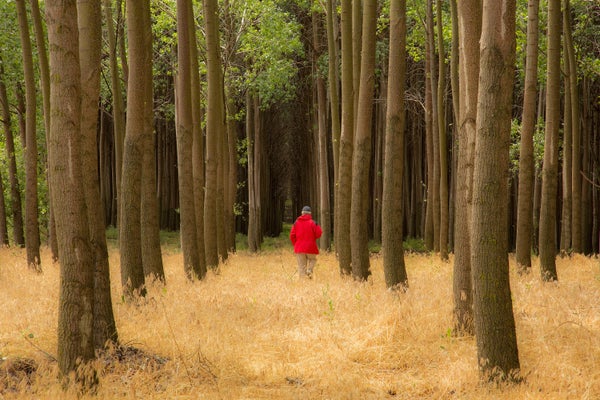Time Spent in Nature Can Be Good—and Sometimes Bad— for Your Brain
A “Goldilocks” measure of green space might help stave off dementia, but an excess could lead to cognitive decline

There’s nothing like a good walk through your local park to unwind and release stress from a busy day. Taking some time in nature is undeniably good for you, with well-documented benefits to physical and mental health. But new research suggests that when it comes to the risk of dementia and Alzheimer’s disease, easy access to nature can sometimes help but, at other times, can be too much of a good thing.
The causes of dementia—a broad category of conditions that can affect memory, language and other brain capacities—are multifaceted and complex. There is often a genetic component, but there are also contributions from health risk factors that arise throughout life. In 2024 the Lancet Commission on dementia identified 14 such factors that reliably increase the risk of developing dementia. These include physical health factors such as cardiovascular disease, high LDL cholesterol, diabetes, and obesity and traumatic brain injury, as well as psychological factors such as depression and social isolation.
Thousands of studies provide solid evidence about the dangers of these risk factors, but researchers are far from having all the answers about dementia. In the past 10 or so years, researchers have begun looking beyond these established risks to the effect of an individual’s physical and social environment, which might be more under our control than factors such as genetic predisposition. You might not be able to change your genes, but in some cases, you can change where you live or your hobbies or habits. According to Marco Vinceti of the University of Modena and Reggio Emilia in Italy, “there is growing and convincing evidence that risk of neurodegenerative disease, including cognitive impairment and dementia, can be substantially reduced by environmental and behavioral factors, and this may even be true in individuals having high genetic susceptibility.” Studying the role of environmental factors has led to the recent discovery that exposure to air pollution (such as from wildfire smoke or heavy traffic) increases your chances of developing dementia. This is also the line of questioning that led researchers to discover the positive effects of green space.
On supporting science journalism
If you’re enjoying this article, consider supporting our award-winning journalism by subscribing. By purchasing a subscription you are helping to ensure the future of impactful stories about the discoveries and ideas shaping our world today.
The benefits of green space for mental and brain health are numerous. Living near and spending time in green space (including parks, wooded areas and even farmland) can decrease the risk of cardiovascular disease and type 2 diabetes and is associated with a lower risk of Alzheimer’s disease and other forms of dementia later in life. According to Anjum Hajat, an epidemiologist at the University of Washington School of Public Health, access to green space “is important because it provides people with an easy, low-cost option to improve their health. Spending time in nature may have other benefits, too, like increasing physical activity or increasing time spent with friends and family; both of these things have many health benefits.”
Based on this research, you might be ready to give up city life. You might presume that more green space is better, and that living on a few wooded acres with nothing but trees for miles around will lead to the lowest possible chance of dementia. It turns out this is not so simple. A 2022 research study led by Federico Zagnoli of the University of Modena and Reggio Emilia revealed that more green space is not always better. The researchers found a U-shaped association between exposure to green space and dementia risk—low levels of green space were associated with a higher likelihood of developing dementia, and medium levels were linked to a lower risk. But the highest level of green space exposure didn’t reduce dementia risk relative to the medium level—and in some cases even increased it! In other words, too little green space has an adverse effect, but so might too much of it.
Why might more of a good thing be bad? Living out in nature can mean lower access to medical and social services, fewer places to socialize and higher chances of social isolation—circumstances that would otherwise support brain health and reduce dementia risk. Although research on some of these factors is still ongoing and not yet certain, there is solid evidence for the risks of social isolation. As Vinceti puts it, “The higher risk of dementia associated with ‘extremely high’ green spaces around the place of residence is likely attributable to social isolation and socioeconomic disadvantage in certain rural areas. Rurality may also be correlated with other risk factors, such as lower socioeconomic status or high pesticide exposure.” So the conclusion is that green space itself is not bad for your brain health, but living on a few acres of land surrounded by forest and farmland might increase your risk of dementia in other ways. Although trees have a positive effect, they are no substitute for a nearby hospital, local community center and a walkable neighborhood with friendly neighbors. Aiming for the lowest possible dementia risk is all about a balance: enough neighborhood density to have easy access to services and social support but plenty of trees for a walk in the park.
.

